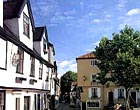Property Guide to Norfolk
Nofolk used to be perceived as remote from London and therefore less desirable than the Home Counties, but prices in this pretty county are quickly catching up with the more south-easterly parts of England.


In Norman times, Norfolk was the most populous part of England; later, it became a centre of the wool trade, but its prosperity declined after the mid 16th century. There is a good supply of rectories and farmhouses, partly thanks to this early wealth, together with an abundance of well-built parish churches and a number of large estates, many still in private hands today. Although Norfolk is one of the driest counties in England it is surrounded by water in the form of sea or rivers, and contains the waterways of the Broads in the north-east. The north-west of the county is fen and marshland - a rich habitat for birds. Much of the coastline is reclaimed from the sea, and there are broad expanses of sandy beaches. Norfolk is by no means completely flat, however: in parts, the land rises to 330ft above sea level, and the scenery is varied. There is little good building stone; houses were traditionally constructed of timber, brick and flint. Norfolk's brick architecture is particularly noteworthy. Although the property market in the county was traditionally for hardcore fans, and the self-employed only, changing habits and better transport links have allowed people who find the overcrowding of the Home Counties a bit too much to bear. 'Over the past five years, much has changed in Norfolk,' says Alistair Brown from Strutt and Parker. 'For those working in town or in London three or four days per week, you get a much larger house here than you would closer in to the capital. 'Norfolk is truly one of the last unspoiled counties, and people come for the extremely pretty scenery and the sense of space which cannot be bought any longer in other areas of the country.' But those who are planning to watch how the market develops before sticking their toes in the water are advised to make a move sooner rather than later if they want to buy there, according to many agents: some parts of Norfolk are becoming as popular as the Cotswolds, and demand is outstripping supply. 'In places like Brancaster and Burnham Market you can get a better lifestyle than in the Home Counties, without the price tag, although these areas are now achieving prices which would have been unheard of previously,' says Tim Stephens from Humberts. 'Although there aren't many good houses for sale just now, into May we expect to see more property come onto the books, and sales start to take off.' Mr Stephens also feels that a couple of areas which are not yet hotspots, but it is only a matter of time before they are, are places like Thorpe Market which haven't yet been labelled as trendy: 'It's not so much 'location, location location', but more like 'perception perception perception,' he declares. Major townsNorwich, King's Lynn, Cromer, Great Yarmouth, Fakenham, Thetford, Swaffham, Hunstanton, Diss. Transport links Train: Liverpool Street to Norwich 1hr 50min; Liverpool Street to King's Lynn 1hr 35min. Car: Norwich is 115 miles from London, via the M11 and A11; King's Lynn is 97 miles, via the M11 and A10. Public schoolsBeeston Hall, West Runton, Cromer +44(0)1263 837324. Co-educational, age range 7-13, day and boarding. Glebe House School, Hunstanton +44 (0)1485-532809. Co-educational, age range 4-13, day and boarding. Gresham's School, Holt +44 (0)1263 713271. Co-educational, age range 3-18, day and boarding. Langley School, Loddon 44(0)1508 520210. Co-educational, age range 11-18, day and boarding. Norwich High School+44(0)1603 453265. Girls only, age range 4-18, day. Norwich School+44(0)1603 623194. Boys only (co-educational sixth form), age range8-18, day. Wymondham College(0)1953 609000. Co-educational, age range 11-18, day and boarding. Leisure Golfcourses: Royal Cromer (01263 512884); Royal Norwich (01603 425712); Royal West Norfolk, King's Lynn (01485 210223). Hunts: The West Norfolk. Yacht clubs: Norfolk Broads Yacht Club; Royal Norfolk and Suffolk Yacht Club. Fishing: rivers Bure, Wissey, Yare, Waveney, and the Broads.
Exquisite houses, the beauty of Nature, and how to get the most from your life, straight to your inbox.
Country Life is unlike any other magazine: the only glossy weekly on the newsstand and the only magazine that has been guest-edited by His Majesty The King not once, but twice. It is a celebration of modern rural life and all its diverse joys and pleasures — that was first published in Queen Victoria's Diamond Jubilee year. Our eclectic mixture of witty and informative content — from the most up-to-date property news and commentary and a coveted glimpse inside some of the UK's best houses and gardens, to gardening, the arts and interior design, written by experts in their field — still cannot be found in print or online, anywhere else.
-
 A Georgian farmhouse that's an 'absolute gem' in an ancient village on Salisbury Plain
A Georgian farmhouse that's an 'absolute gem' in an ancient village on Salisbury PlainJulie Harding takes a look at the beautiful West Farm in a gorgeous Wiltshire village.
-
 Can you guess the landmark from its gingerbread copy cat? Take our quiz
Can you guess the landmark from its gingerbread copy cat? Take our quizToday's quiz takes a detailed look at the gingerbread works on display at London's The Gingerbread City — and asks if you can guess which iconic landmark they are.
